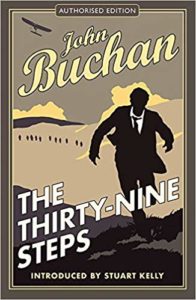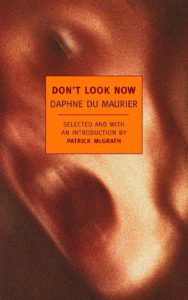I live on a film set.
The particular part of Scotland where I live is a beautiful part of the world: scenic, steeped in history, myth and legend. It’s something many film and TV makers have cottoned on to. So much so that, a great many of you reading this piece are already very familiar with where I live: the series Outlander is filmed here, and for those Python fans among you, the French castle in Monty Python and the Holy Grail was filmed nearby. The same castle also featured in the recent Chris Pine movie, Outlaw King.
And the scenery I live with has shaped a lot of literary landscapes too. Believe it or not, I can walk from my house to Ben Gunn’s Treasure Island, cave—although he’s never in when I call round and I have yet to locate his buried treasure. It’s all because a young RL Stevenson was sent to enjoy the clean, fresh air of this neck of the woods to recuperate from his various ailments. While exploring the woodland walks around here he discovered an ancient cave which served as the model for Gunn’s retreat in Treasure Island. And, as I will discuss later, this part of the world has played, both in the novel and cinematically, a central role in one of the most compelling adventure stories of my youth.
It’s therefore not surprising that storytelling and a sense of place and time have always been indissolubly linked for me, which partly explains my own literary wanderings as an author. But it’s more than that: through some personality defect, I enjoy the mental liberty—chronological and geographical—that being a writer brings. It allows you to experience another place and time; to put yourself in someone else’s shoes, to walk somewhere other’s streets, to breathe in a different air. Whether the location has been native or adopted, some authors have had the knack of making the setting of their stories more than a location, but one of the principal characters. There is no better reading experience than to finish a novel or a short story and feel that you have been transported to another place, time, or both. Here are five pieces of literature that I feel do just that.

The Scottish Highlands
John Buchan, The Thirty-Nine Steps
My neck of the woods, in so many ways. I loved this book as a kid and re-read it—in a day and a half—only a few months ago. John Buchan—later Governor General of Canada and Baron Tweedsmuir—was a Scot, but also a product and supporter of the British Empire, which often reflected in his writings. Some of the attitudes and themes in the novel of The Thirty-Nine Steps reflect his point of view, but don’t intrude on what is one of the most compelling chase/race-against-the-clock thrillers of all time. Sometimes gentle, other times harsh and forbidding, the Highland landscape of The Thirty-Nine Steps is more than a backdrop, it is one of the most compelling characters in the book, capriciously offering alternating shelter from and exposure to threat, its mood reflected in the ever-changing sky. It is hardly surprising that Alfred Hitchcock was drawn to the novel; Buchan uses the Highlands as a psychological landscape, its raw openness and wildness contrasting with the elegance and comfort of Richard Hannay’s London apartment. For me there was a bit of a literary segue from childhood enthrallment with the desperate flight through the glens and mountains of David Balfour and Alan Breck Stewart in RL Stevenson’s Kidnapped, harassed by both searching redcoats and in the climatic extremes of the Highlands.
These pursuits have left their mark on me as a writer. I even took one of my own heroes, Lennox, on a desperate chase across highland moor and mountain.
The Thirty-Nine Steps and its iconic power extend beyond the page. I also grew up with the movie versions, especially the Hitchcock’s classic, in all of which the Scottish Highlands played the lead role. I admit to having affection for the (greatly inferior) 1959 Kenneth More version—simply because the scene where Hannay leaps from the Sherriff’s office window (yes, we have sheriffs in Scotland, but they’re district judges not peace officers) and onto a conveniently passing haycart—was filmed in my home town.

Venice, Italy
Daphne Du Maurier, “Don’t Look Now”

Cornwall, England
Daphne Du Maurier, “The Birds”
In my opinion, Du Maurier was one of the greatest ever writers of psychological unease. How she managed to lever so much into the inevitably constraining short story form fills me with absolute wonder. And the writing never shows: you are unaware of her brush strokes as she colors a normal world, populated with ordinary people, with tones of the uncanny and disquieting. Du Maurier allowed no restriction to her imagination and wrote across genres, periods, styles and themes. What united all her work was the power with which she conveyed a sense of place, again making the landscape a character, often a dark and brooding character, in everything she wrote. This perhaps explains why she was also an extremely cinematic writer, leading to all of her major works being adapted into film, often multiple times.
Two of her shorter works, the short stories “Don’t Look Now” and “The Birds,” were made into highly successful movies. Alfred Hitchcock’s The Birds was a box-office smash, yet Du Maurier was unhappy with the film version. Conversely, she was delighted with Nick Roeg’s treatment of Don’t Look Now, a production that attracted significant controversy. Having read both short stories, I understand Du Maurier’s position on the films. Du Maurier famously wrote about her beloved Cornwall, especially the Cornish coast, but she moved as far away, culturally as much as geographically, with the short story Don’t Look Now. Set in Venice, the story communicates the fading majesty of the world’s most beautiful city. A sense of what I can best describe as ornate doom, derived largely from the beautiful architecture and the dark weavings of the canals, pervades the story. Du Maurier uses this as a physical reflection of the young couple’s grief at the recent death of their daughter. The result is a towering piece of modern gothic literature.
Most people will know The Birds from the film adaptation rather than the original short story. This is a shame, because the original story is much richer in texture and meaning, and a great of that texture derives from Du Maurier’s description of her native Cornwall. In the story, the landscape is absolutely central to the whole concept of the story: instead of the movie’s gloss of a high society couple, the story concerns a farm-worker and his protection of his family. One assumption is that the abnormal behavior of the birds is tied to abnormality in the climate, and the farmworker protagonist is portrayed as someone who can read the sky, the sea and the land. All of which was lost in the Hitchcock movie, as was the story’s drama of topography and climate, being transported to the California coast.

New York
Ira Levin, Rosemary’s Baby
This novel was a game changer—and a genre regenerator. Rosemary’s Baby opened—or reopened—the door for horror fiction, which enjoyed a new heyday in the sixties and seventies. It is a modern novel, in a modern setting, but what I admire about it most is the way that it is, at the end of the day, a classic Gothic novel, masterfully employing all of the conventions and devices of the classic form, yet infusing it with modern psychological terror. In my opinion, Rosemary’s Baby is a masterpiece.
One of the classic Gothic conventions, the forbidding fortress, looms large over the entire tale. But instead of a remote mediaeval castle cloaked in forest, this fortress takes the form of a Gothic Revival apartment house, the Brampton (a thinly disguised German Renaissance Dakota), and the streets of contemporary (1960s) Manhattan substitute with great effect for the forests of Mitteleuropa or the canals of Venice.
The New York of the novel is so very cleverly crafted as the Other. The reader shares Rosemary’s perceptions of the city, which she views from the start with uncertainty and outright unease. She is aware of both her different perspective and her socio-cultural disconnect, as a Nebraskan, from the New Yorkers who surround her. Rosemary’s midwestern nice politeness and naivety, her lack of assimilation in comparison to the success of that of her husband, Guy, underline her isolation. It’s this presentation of a familiar location through unfamiliar eyes that allows the reader to share Rosemary’s unease, sense of otherness, and fear that what she first thought as strange is actually malignant. Added to that is Levin’s consummate skill in painting the big city as a restrictive and oppressive environment, climatically, socially, culturally. To the extent that, every time I read the book, I’m still never sure if the horror around her is real, or the result of Rosemary’s paranoia.
Fantastic stuff.

Transylvanian Romania (via Whitby, England)
Bram Stoker, Dracula
This is almost location as geopolitical statement.
The essential element of Gothic horror—and nothing so perfectly exemplifies Gothic horror as Dracula—is the sense, and dread, of the ‘Other’. Bram Stoker, though Irish, was very much a product of the British Empire, in the same way as the Scot John Buchan would be later in the Empire’s history. Stoker therefore shared an imperialist world view, where the ‘Other’ was represented by the ineffable exoticism of the foreign. So, when Stoker looked to form a monster out of the shadow and fog of the Other, he looked beyond the British Isles to Eastern Europe and the unknown landscape of Transylvania. When, after an arduous and potentially hazardous journey through unknown terrain, Jonathan Harker encounters Dracula in his Transylvanian castle, it is a direct Victorian equivalent of Ripley encountering the xenomorph in Ridley Scott’s Alien. In both scenarios, the Other is encountered in an alien landscape and the danger is that it will find its way into our ‘normal’ world. At the time Stoker wrote Dracula, despite the British Empire being at its height, there was an awareness of the vulnerability of the small island at its heart. This gave birth to a new genre—invasion literature. Many of the biggest names of the day wrote at least one invasion literature novel and, on publication, Dracula was seen as much an invasion thriller as a Gothic novel. This is perfectly understandable, given the choice of locations. Transylvania is dark and unknown and, most importantly, it lies beyond the reach and ken of the British Empire. Whitby, a gentle English coastal town, embodies the purity about to be corrupted by the Transylvanian Other.
Stoker knew Whitby, but never visited Romanian Transylvania, although he read intensively about the region. And it’s here that I can lever in a Scottish connection (well, I would, wouldn’t I?): nineteenth century Scottish novelist and travel writer Emily Gerard married a Polish officer in the Austro-Hungarian army who was posted to Transylvania. While there, Gerard undertook an extensive survey of the local folklore and myth—it was she who introduced the outside world to the name nosferatu. Bram Stoker used Gerard’s Transylvanian journal The Land Beyond the Forest extensively in his research.
And I have a copy of The Land Beyond the Forest myself …
***
There are so many other examples of unforgettable use of location in literature—the Colorado Rockies in Stephen King’s The Shining, Dublin in James Joyce’s Ulysses and Dubliners, Victorian London in Stevenson’s The Strange Case of Doctor Jekyll and Mister Hyde, the Italian Riviera of Patricia Highsmith’s The Talented Mr Ripley … The five examples I have given have been perhaps the most influential on me and have contributed enormously to my literary wanderlust. And why I ended up in a converted castle-turned-asylum in 1930s Czechoslovakia. Creatively speaking, of course.


















